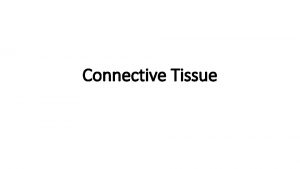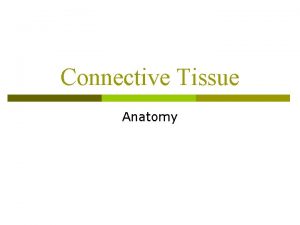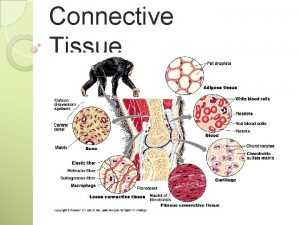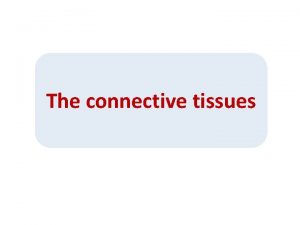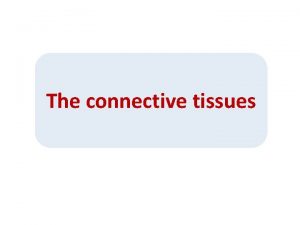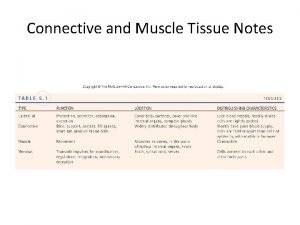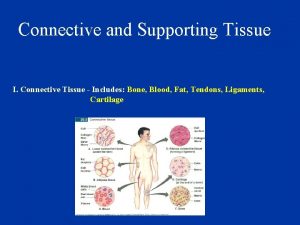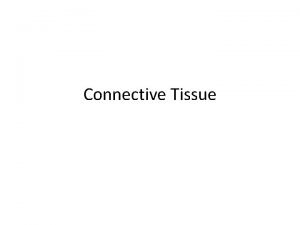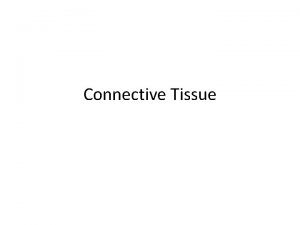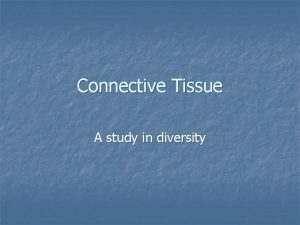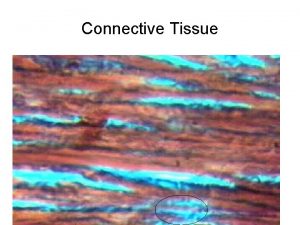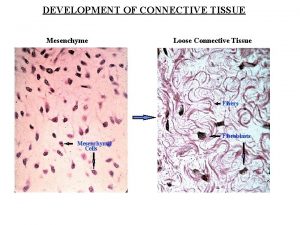CONNECTIVE TISSUE Anatomy and Physiology CONNECTIVE TISSUE Functions




















- Slides: 20

CONNECTIVE TISSUE Anatomy and Physiology

CONNECTIVE TISSUE • Functions: • Connects, supports, protects, provides frameworks, fills spaces, stores fat, produces blood cells, protects against infection, and helps repair damaged tissues • Connective tissue has a lot of intercellular matrix between them which consists of fibers

CONNECTIVE TISSUE • Major cell types • Fibroblasts (most common cells in connective tissue) • Macrophages • Mast cells • Connective Tissue Fibers • Collagenous fibers • Elastic fibers • Reticular fibers

LOOSE CONNECTIVE TISSUE • Forms delicate thin membranes throughout the body. • The cells are located far apart and are connected by a gel -like matrix • Function: bind organs together, hold tissue fluids • Location: Beneath skin, between muscles, beneath epithelial tissues

ADIPOSE TISSUE • “Fat” • Function: Protect, insulate, store fat • Location: Beneath skin, around kidneys, behind eyeballs, on surface of heart • This develops when certain cells store fat in droplets within their cytoplasm and enlarge. Many of these cells make up adipose tissue.

DENSE CONNECTIVE TISSUE • Closely packed, thick, collagenous fibers, fine network of elastic fibers. • Very few cells (fibroblasts) • The collagenous fibers are strong which allows it to be pulled. • Function: Binds organs together • Location: tendons, ligaments, deeper layers of skin

CARTILAGE • Rigid connective tissue • Function: support, framework, attachment, protect underlying tissues, form structure for developing bone • Composed of collagenous fibers • Lack of a direct blood supply to cartilage tissue, torn cartilage heals very slowly and their cells (chondrocytes) do not divide easily • 3 Types of cartilage • Hyaline cartilage • Elastic cartilage • Fibrocartilage

HYALINE CARTILAGE • Most common type of cartilage! • Made up of fine collagenous fibers • Important for growth of bones • Function: supports, protects, provides framework • Location: nose, ends of bones, rings in the wall of the respiratory passage

ELASTIC CARTILAGE • Many elastic fibers • More flexible than hyaline cartilage • Function: supports, protects, provides flexible framework • Location: Framework of external ear and parts of the larynx

FIBROCARTILAGE • Tough tissue, contains thick collagenous fibers • Function: Supports, protects, absorbs shock • Location: Between bony parts of spinal column, parts of pelvic girdle and knee

BONE • Most rigid connective tissue • Hard due to mineral salts • It’s matrix contains a lot of collagen (the fibers flexibly reinforce the mineral components of bone) • Function: Supports, protects, provides framework • Location: Bones of the skeleton

BLOOD • Function: transports substances, helps maintain stable internal environment • Location: Throughout the body within a closed system of blood vessels and heart chambers.

IDENTIFY THE TISSUE TYPE

BONE

BLOOD

HYALINE CARTILAGE

FIBROCARTILAGE

ELASTIC CARTILAGE

LOOSE CONNECTIVE TISSUE

DENSE CONNECTIVE TISSUE
 Necessary life functions anatomy and physiology
Necessary life functions anatomy and physiology Characteristics of dense irregular connective tissue
Characteristics of dense irregular connective tissue The upper airways
The upper airways Tattoo anatomy and physiology
Tattoo anatomy and physiology International anatomy olympiad
International anatomy olympiad Woody stem parts
Woody stem parts Anatomy and physiology of bone
Anatomy and physiology of bone Ulcer definition anatomy
Ulcer definition anatomy Segmental anatomy of the liver
Segmental anatomy of the liver Epigastric region
Epigastric region Hypogastric region
Hypogastric region Rbc anatomy and physiology
Rbc anatomy and physiology The central sulcus divides which two lobes? (figure 14-13)
The central sulcus divides which two lobes? (figure 14-13) Endomysium
Endomysium Http://anatomy and physiology
Http://anatomy and physiology Chapter 1 introduction to human anatomy and physiology
Chapter 1 introduction to human anatomy and physiology Anatomy and physiology of appendicitis
Anatomy and physiology of appendicitis Aohs foundations of anatomy and physiology 1
Aohs foundations of anatomy and physiology 1 Aohs foundations of anatomy and physiology 1
Aohs foundations of anatomy and physiology 1 Anatomy and physiology of swine
Anatomy and physiology of swine Anatomy and physiology chapter 8 special senses
Anatomy and physiology chapter 8 special senses
























